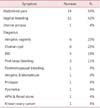Abstract
Objectives
The objective of this study was to assess the clinical characteristics of postmenopausal women who were admitted to the emergency room.
Methods
This study was conducted at a university hospital. The retrospective study of medical records comprised 26 patients who were admitted to the emergency room, between September 2010 and August 2011.
Results
The age of the twenty-six patients was 51-90 years. Abdominal pain and vaginal bleeding were the main complaints. The final diagnoses were 6 cases of postmenopausal atrophic vaginitis, 6 cases of ovarian cyst, 5 cases of pelvic inflammation disease, 3 cases of post-conization bleeding, 1 case of menopausal symptoms, 1 case of atrophic endometrium, 1 case of uterine prolapse, 1 case of pyometra, and acute pyeolonephritis with stone. Among the 6 cases of ovarian cyst, 5 cases performed an operation. Pathologic findings revealed 2 cases of simple cyst, 1 case of paratubal cyst, 1 case of teratoma, and 1 case of granulosa cell tumor.
Figures and Tables
References
1. Korean Statistical Information Service. Population Projections for Korea. 2012. cited by 2011 Jul 1. Daejeon: Statistics Korea;Available from: http://kosis.kr/ups/ups_01List01.jsp?pubcode=PJ#.
2. Kim HC. A brief introduction to ambulatory office practice in geriatric gynecology (Part I). J Korean Soc Menopause. 2008. 14:185–207.
3. Shin JS, Park CH, Yoo EH, Lee SG. Leukocytes and lactobacilli of vaginal discharge as a predictor of pelvic inflammatory disease. Korean J Obstet Gynecol. 2007. 50:1247–1253.
4. Cho MK. Update on the management of pelvic inflammatory disease. Korean J Obstet Gynecol. 2010. 53:961–966.
5. Lee CH, Raman S, Sivanesaratnam V. Torsion of ovarian tumors: a clinicopathological study. Int J Gynaecol Obstet. 1989. 28:21–25.
6. Whiteley PF, Hamlett JD. Pyometra--a reappraisal. Am J Obstet Gynecol. 1971. 109:108–112.
7. Swift SE, Pound T, Dias JK. Case-control study of etiologic factors in the development of severe pelvic organ prolapse. Int Urogynecol J Pelvic Floor Dysfunct. 2001. 12:187–192.
8. Norton PA. Pelvic floor disorders: the role of fascia and ligaments. Clin Obstet Gynecol. 1993. 36:926–938.
9. Kim SH. Diagnosis and treatment of pelvic organ prolapse. Korean J Obstet Gynecol. 2006. 49:501–512.
10. Stanton SL. Shaw RW, Souter WP, Stanton SL, editors. Vaginal prolapse. Gynaecology. 1992. Edinburgh: Churchill Livingstone;437–447.




 PDF
PDF ePub
ePub Citation
Citation Print
Print





 XML Download
XML Download